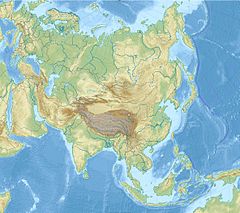Mausoleum of Abdul-Qadir Gilani
| Mausoleum of Abdul-Qadir Gilani | |
|---|---|
 The mausoleum complex in 2016 | |
| Religion | |
| Affiliation | Sunni Islam |
| Rite | Qadiriyya Sufi |
| Ecclesiastical or organisational status | Mosque and shrine |
| Status | Active |
| Location | |
| Location | Al-Rusafah, Baghdad, Iraq[1][2] |
Location in Baghdad | |
| Geographic coordinates | 33°20′11.22″N 44°24′28.76″E / 33.3364500°N 44.4079889°E |
| Architecture | |
| Type | Islamic architecture |
| Specifications | |
| Minaret(s) | 2 |
| Shrine(s) | 2 |
The Mausoleum of Abdul-Qadir Gilani, also known as Al-Ḥaḍrat Al-Qādiriyyah (Arabic: ٱلْحَضْرَة ٱلْقَادِرِيَّة) or Mazār Ghous (Persian: مزار غوث), is an Islamic religious complex dedicated to Abdul Qadir Gilani, the founder of the Qadiriyya Sufi order, located in Baghdad, Iraq. Its surrounding square is named Kilani Square. The complex consists of the mosque, mausoleum, and the library known as Qadiriyya Library, which houses rare old works related to Islamic Studies.[1][2] The son of the entombed scholar, Abdul Razzaq Gilani, is also buried there.
History
[edit]
The complex was built near the Bāb Ash-Sheikh (Arabic: بَاب ٱلشَّيْخ, romanized: The Sheikh's Gate) in Al-Rusafah, on the east bank of the Tigris.[1][3][4] Al-Rusafah also contains the mosque of the founder of the Hanbali school of thought, Imam Ahmad ibn Hanbal.[5][6]
During the reign of the Safavid Shah Ismail I, Gilani's shrine was destroyed.[7] However, in 1535, the Ottoman Sultan Suleiman the Magnificent had a dome built over the shrine, and it exists to this day.[8]
Terrorist incident
[edit]On 28 May 2007, the shrine was targeted by a car bomb attack which killed around 24 and injured 68. The attack caused serious damage to the shrine and the mosque, and destroyed the outer wall, a dome and a minaret.[9]
See also
[edit]References
[edit]- ^ a b c Alwan, Walid Abdulamir (May–June 2005). Al-Salami, Fadel Abbas (photographer) (ed.). "The Qadirya Mausoleum, Shrine of a famous sufi leader" (PDF). Islamic Tourism (17). Retrieved 2017-12-25.
- ^ a b "Jilani Shrine the Sufi Heart of Baghdad". The Express Tribune. 2015-03-22. Retrieved 2017-12-25.
- ^ Al-Ghunya li-talibi tariq al-haqq wa al-din (Sufficient provision for seekers of the path of truth and religion), parts one and two in Arabic, Al-Qadir, Abd and Al-Gilani. Dar Al-Hurya, Baghdad, Iraq, (1988).
- ^ Al-Ghunya li-talibi tariq al-haqq wa al-din (Sufficient provision for seekers of the path of truth and religion) with an introduction by Al-Kilani, Majid Irsan. Al-Kilani, Majid, al-Tariqat, 'Ursan, and al-Qadiriyah, Nash'at
- ^ Imam Ahmed bin Hanbal Shrine: Dargah Of: Imam Abu Abdullah Ahmed bin Mohammed bin Hanbal (Rahimahu Allahu Ta'ala), Dargahinfo.com, retrieved 2020-07-13
- ^ Imam Ahmed bin Hanbal Shrine: Imam Abu Abdullah Ahmed bin Mohammed bin Hanbal (Rahimahu Allahu Ta'ala), Dargahinfo.com, retrieved 2020-07-13
- ^ Duri, A. A. "Baghdad". The Encyclopaedia of Islam. Vol. I. p. 903.
- ^ Braune, W. "Abd al-Kadir al-Djilani". The Encyclopaedia of Islam. Vol. I. p. 70.
- ^ مقتل وجرح العشرات ببغداد وإطلاق 41 محتجزا ببعقوبة. Al Jazeera. Retrieved December 25, 2017.




